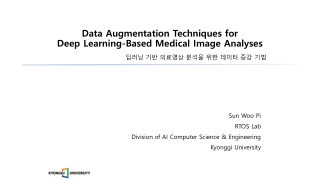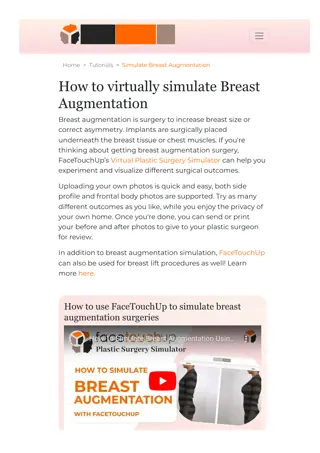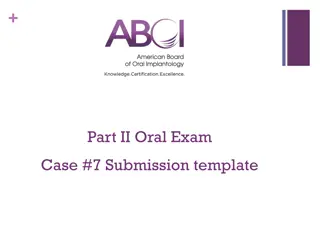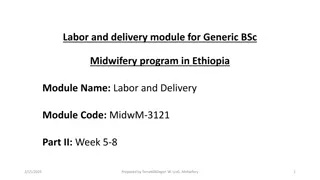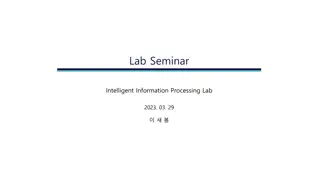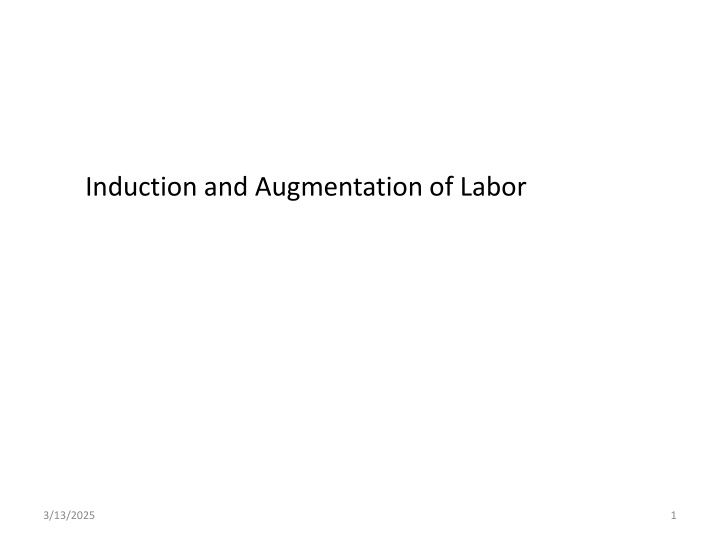
Induction and Augmentation of Labor
In this comprehensive guide, learn about the definitions, indications, methods, and complications related to the induction and augmentation of labor. Understand the different medical and surgical approaches used, along with potential risks involved. Explore the reasons for initiating labor and the necessary preconditions for safe delivery.
Download Presentation

Please find below an Image/Link to download the presentation.
The content on the website is provided AS IS for your information and personal use only. It may not be sold, licensed, or shared on other websites without obtaining consent from the author. If you encounter any issues during the download, it is possible that the publisher has removed the file from their server.
You are allowed to download the files provided on this website for personal or commercial use, subject to the condition that they are used lawfully. All files are the property of their respective owners.
The content on the website is provided AS IS for your information and personal use only. It may not be sold, licensed, or shared on other websites without obtaining consent from the author.
E N D
Presentation Transcript
Induction and Augmentation of Labor 3/13/2025 1
Outline Define induction and augmentation of labor List indications for labor induction Discuss procedures and preconditions for labor induction/augmentation Discuss methods of labor induction and augmentation Describe complications of induction and augmentation 3/13/2025 2
Definitions Induction of labor artificial initiation of labor after fetal viability for clear maternal and fetal indications Augmentation of labor- artificial stimulation of uterine contractions in cases of inefficient uterine contractions to attain required efficiency to effect delivery Induction and augmentation of labor can be achieved through medical and surgical means or a combination of both Induction and augmentation interventions incur maternal and fetal risks and should be institute with clear medical indications and after informed maternal consent 3/13/2025 3
Indications for Induction of Labor Maternal Fetal Intrauterine fetal death Pre-eclampsia/Eclampsia Chronic hypertensive disease Antepartum hemmorhage Premature rupture of the membranes Congenital anomaly incompatible with life RH Isoimmunization Fetal growth restriction Post term pregnancy Diabetes mellitus in pregnancy Abnormal fetal well being tests suggesting chronic intrauterine asphyxia Indications are classified as maternal and fetal based on the predominant reason for termination. In most cases maternal and fetal indications overlap and may be difficult to classify as maternal and fetal. 3/13/2025 4
Methods of Labor Induction and Augmentation Medical Surgical Combination of both 1.Oxytocin infusion Low dose regimen- beginning at 1mu/min and doubling every 20-30 mins to a maximum of 40 mu/min High dose regimen- start at 6mu/min and escalate every 20-30 mins to a maximum of 42 mu/in 2.Prostaglandin E 1( Misoprostol) induction intravaginal or intracervical 3.Prostaglandin E 2 ( Dinoprostone) 3 mg vaginally every 6 hours for two four doses 1. Amniotomy artificial rupture of the membranes 2. Stripping of the fetal membranes 3. Foley catheter method 1. Amniotomy with oxytocin induction 2. Stripping of fetal membranes with oxytocin induction 3. Foley catheter method with oxytocin induction .. Etc Surgical methods are often used in conjunction with medical methods and not alone for labor induction. Most methods of labor induction are also used for augmentation of labor as well. 3/13/2025 5
Pre requisites for labor induction Valid indication Obtain informed consent of the mother Assure fetal maturity - > 39 completed weeks or fetal lung maturity tests Rule out contraindications for vaginal delivery Assess pelvic adequacy Assess favorability of cervix by the Bishop s Score Assess presentation ( vertex) and fetal size Induction to be conducted mostly as an elective planned procedure with maternal preparation hemoglobin determination, NPO except fluids etc Sometimes emergency inductions may also need to be conducted due to obstetric emergencies such as eclampsia and abruptio placenta 3/13/2025 6
The Bishop Score Parameter 0 1 2 3 Cervical dilatation Closed 1-2 3-4 >5 Cervical effacement 0-30% 40-50% 60-70% >80% Cervical position Posterior Midposition Anterior _ Cervical consistency Firm Medium Soft _ Fetal station -3 -2 -1,0 +1,+2 The Bishop score indicates the ripening of the cervix for labor indirectly indicating the possibility of success of an induction. Scores > 9/13 indicate a ripe cervix; 5-8 intermediate cervix and < 4 an unripe cervix and a high probability of unsuccessful induction. 3/13/2025 7
Methods of Cervical Ripening Pharmacological Mechanical Prostaglandin E2 (dinoprostone)- intravaginal, intracervical repeated 3-5 mg doses applied until the cervical status improves or a maximum of three to four doses Prostaglandin E1 (misoprostol) intravaginal or oral Foley catheter method Stripping of the fetal membranes Laminaria insertion into the cervix hygroscopic dilators that dilate and soften the cervix by absorbing its water content. Extracts of laminaria sea weeds. Un unripe cervix needs to be ripened by these cervical ripening methods in order to be softened and more ripe. The pharmacologic methods are the most preferred but in cases where these are not accessible, mechanical agents can also be used to ripen the cervix. A ripe cervix indicates a dilated, soft, anterior and effaced cervix that is easily pliable to uterine contractions. 3/13/2025 8
Procedures of Labor induction Procedure Description Complications Cord prolapse Infection chorioamnionitis Abruptio placentae- if sudden decompression of uterus occurs due to excessive release of amniotic fluid Amniotomy After ascertaining the fetal station and ruling out cord presentation membrane is ruptured with an amnion hook or a kocker and controlled release of amniotic fluid effected Uterine hypertonus fetal distress; uterine rupture Water intoxication sodium retention and fluid overload Hypersensitivity reaction to oxytocin Higher risk of atonic PPH Oxytocin infusion An IV line is opened and oxytocin infusion administered gradually by either a graduated perfusor prepared for the purpose or by IV drip method manually calibrated dosage expressed in mu/min 3/13/2025 9
Procedures for Labor Induction Procedure Description Complications Prostaglandin E1, E2 induction Usually applied for cervical ripening but also used for induction of labor. Tablet or gel or cream inserted at the posterior fornix or near the cervix repeatedly at 6 hourly intervals until labor is established Nausea, vomiting, diahorrea, fever, chills, respiratory complications ( rare), uterine hypertonus- fetal distress, uterine rupture Stripping of the fetal membranes The membranes are separated from the lower uterine segment by the examining finger for 3-4 cms from the os and await for labor onset in hours or days. Possibility of placenta previa and bleeding. Placenta should be localized before membrane stripping. Foley catheter method Foley catheter inserted into the uterus above the internal os, balloon inflated with 30 cc of normal saline and pressure applied by hanging weight of 1 kg ( e.g. IV fluid bag). Infection Membrane rupture 3/13/2025 10
Complications of Labor Induction Prematurity Infection- chorioamnionitis; neonatal sepsis; puerperal sepsis Water intoxication Uterine hypertonus- fetal distress, uterine rupture Hypersensitivity reactions Side effects of prostaglandins Post partum hemmorhage risk Unforeseen cephalopelvic disproportion 3/13/2025 11
Contraindications to induction of labor Fetal distress acute or chronic asphyxia Gross cephalopelvic of feto pelvic disproportion Gross contracted pelvis Malpresentations Fundal uterine scars Multifetal gestations Uterotonics hypersensitivity 3/13/2025 12

